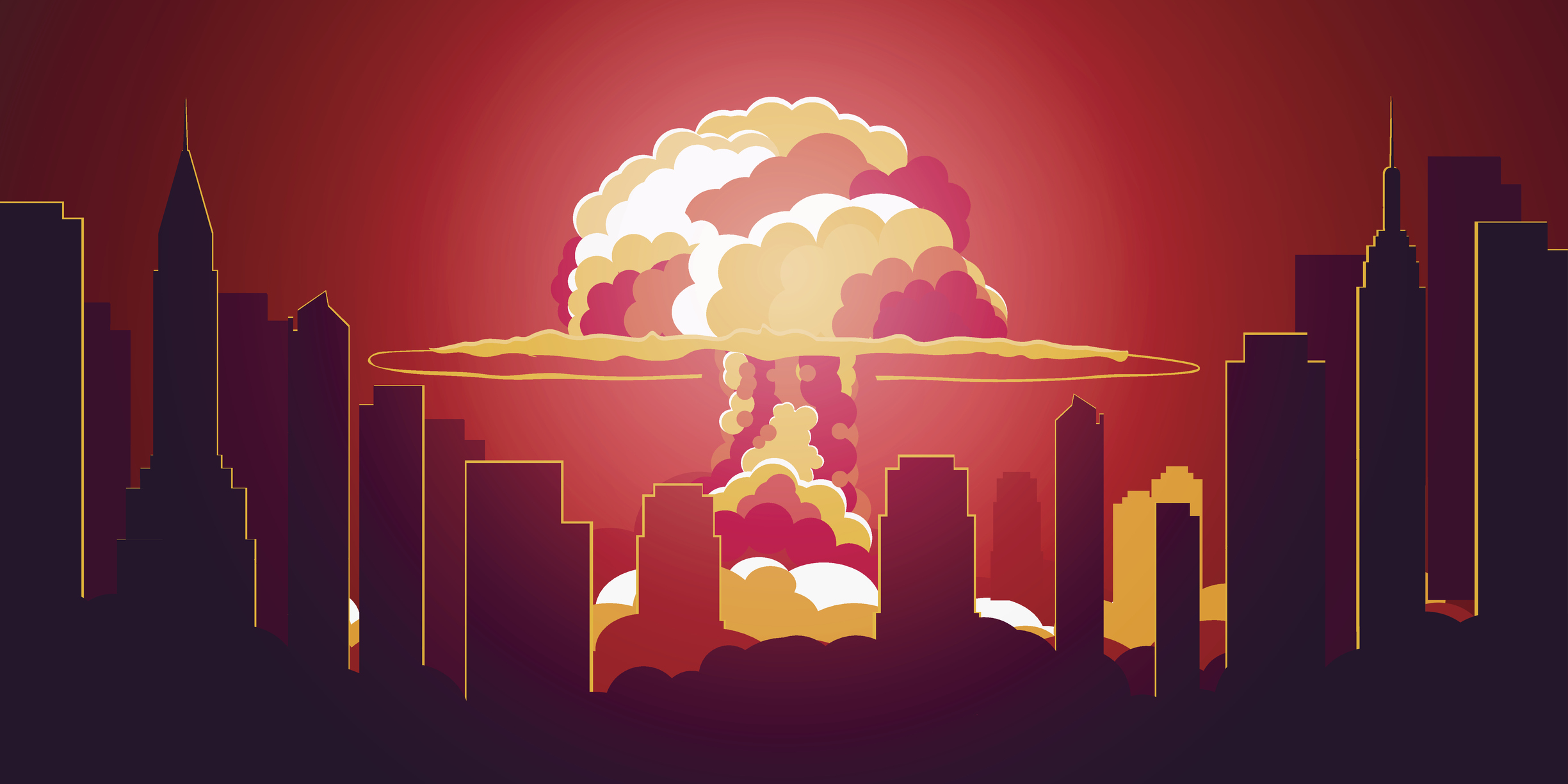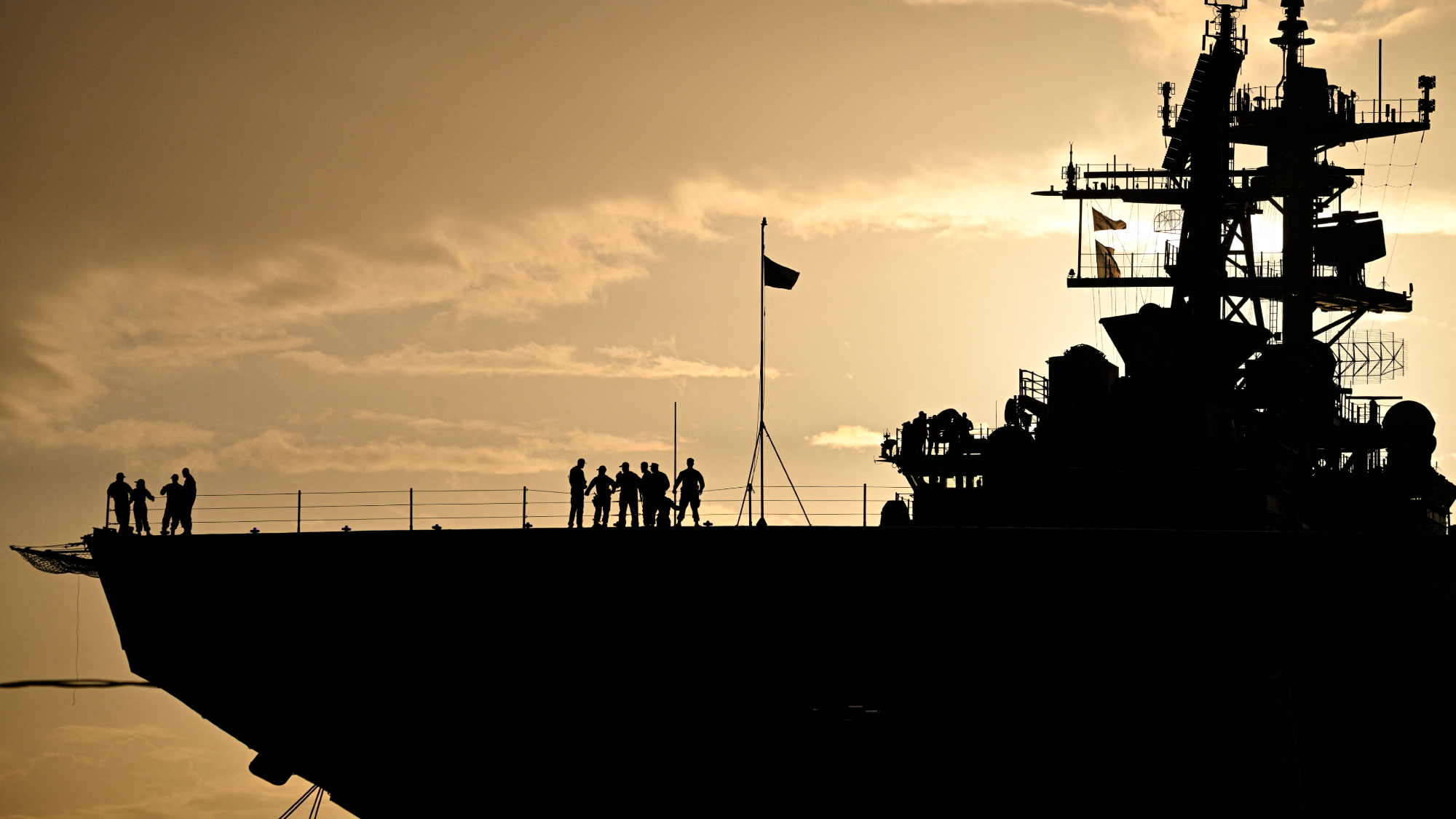How to survive a nuclear attack
Most Americans have no idea what to do if a nuclear bomb detonates where they live or in a nearby city. One group of experts is trying to change our lack of preparedness.

Let's say it's 2 p.m. on a Sunday afternoon and you receive an emergency alert on your cellphone indicating that there has been a nuclear explosion in the next town or that an intercontinental ballistic missile is headed your way.
Would you know what to do? Most likely not.
"I would say that the United States is probably less prepared for any kind of nuclear detonation than it has been at any time since the Cold War," says Alex Wellerstein, a historian of science and technology at Stevens Institute of Technology in Hoboken, New Jersey. "And that is a dangerous place to be."
The Week
Escape your echo chamber. Get the facts behind the news, plus analysis from multiple perspectives.

Sign up for The Week's Free Newsletters
From our morning news briefing to a weekly Good News Newsletter, get the best of The Week delivered directly to your inbox.
From our morning news briefing to a weekly Good News Newsletter, get the best of The Week delivered directly to your inbox.
Wellerstein, along with Kristyn Karl, a political psychology professor at Stevens, is pushing for the U.S. to bring back civil defense, the-all-but-forgotten Cold War–era federal program for preparing and responding to a nuclear event. Exactly what a revamped, 21st-century version of civil defense might look and sound like is the objective of a new project they are directing, called Reinventing Civil Defense. Started in 2016 and funded by the Carnegie Foundation, RCD boasts a diverse, high-powered advisory group that includes everyone from former Secretary of Defense William Perry to nuclear health physicists to screenwriters. The mission: Tell you what to do in the event of a nuclear crisis.
Most Americans — particularly younger ones who did not live through the most dangerous days of the Cold War — have no practical or conceptual idea of how to respond to the warning of an actual nuclear emergency. Witness the scenes of mass panic that took place in Hawaii last January after what turned out to be a false alert about an imminent North Korean attack.
Karl and Wellerstein, along with many other experts, lay much of the blame for this alarming nuclear unpreparedness on the federal government and its failure to communicate how to prepare for such an eventuality. "The government has given Americans no good sense of what, specifically, to do when the next nuclear crisis occurs," says Michael O'Hanlon, a senior fellow at the Brookings Institution.
To be sure, this is not an easy task. The original version of civil defense (also known as Duck and Cover, after its famed guidance to schoolchildren to protect themselves from a nuclear attack by ducking under their school desks when they saw the telltale flash outside) is often remembered as silly and misleading — particularly the impression it gave about how easy it would be to survive a full-scale nuclear war. But Wellerstein and Karl feel that a lot about the original, oft-mocked program was constructive and worth resurrecting — particularly the fact that, at the very least, it did get Americans to think about the unthinkable.
A free daily email with the biggest news stories of the day – and the best features from TheWeek.com
There are at least three different types of credible nuclear threats that exist today — two more than during the Dr. Strangelove days.
Scenario 1 is the fear that set the original civil defense program in motion: an apocalyptic exchange between the U.S. and Russia or China involving hundreds of thermonuclear weapons. The U.S. population would theoretically have a 20- to 30-minute warning before the multi-megaton bombs began bursting in air, spreading radioactive fallout in overlapping lethal circles, and the lights started going out — for good.
Scenario 2 is the nuclear terrorist scenario, i.e., the detonation of a smaller, 10-kiloton device in a major American city. Those fortunate enough not to be among the tens of thousands killed during the initial blast would have a short time to protect themselves from the subsequent fallout.
Scenario 3 is the North Korea scenario, involving the airburst of a 100- or 150-kiloton device over an American city, perhaps Los Angeles, with, hopefully, a 30-minute warning. The result would range from an estimated 195,000 to 241,000 deaths and 510,000 to 629,000 injuries from both the blast and the radioactive fallout, depending on the bomb's yield.
Scenarios 2 and 3 are the most likely — and also the ones that the RCD researchers are focused on (for the moment, at least). They are also survivable, if you and emergency management officials know how to respond. But RCD's first challenge is how to untangle the star-crossed history of the first version of civil defense, says Wellerstein.
It all began with Bert the Turtle — the smiling, helmet-adorned mascot of the first, much-derided civil defense program, which was run by the Federal Civil Defense Administration (the ancestor of FEMA). Bert is the star of a famous 1951 instructional cartoon, called Duck and Cover.
"Bert the Turtle walks down the road," goes the chorus in the famed song, as our smiling hero confidently sashays down the road in the cartoon. "And Bert the Turtle was very alert / When dangers threatened him he never got hurt / He knew just what to do."
The reason Bert and his fellow Americans knew what to do was that they were familiar with the instructions in the upbeat government pamphlet "Survival Under Atomic Attack." "You can live through an atom bomb raid and you don't need a Geiger counter or special training to do it!" the leaflet fatuously advised. "You should hide underground if there is time. Otherwise, you should jump into the nearest gutter or ditch. And don't forget to shut the window!"
Since then, the issue and practice of civil defense has waxed and waned with the rise and fall of international tensions over the following decades, along with the evolving outlook and experiences of the chief occupants of the White House.
President John F. Kennedy, who took office at the start of the second, tensest decade of the Cold War, was a big booster of civil defense. He announced the federal government would initiate a $700 million nationwide fallout shelter plan, while also encouraging Americans to build their own fallout shelters. Kennedy's brother Robert even pressed for a scheme that would require all American citizens to practice evacuation and shelter drills once a week.
Eventually, Kennedy's interest in civil defense waned as he became convinced of the impracticality of a nationwide shelter program, as well as the unwinnability of nuclear war. (As Harvard economist and key Kennedy adviser John Kenneth Galbraith wrote in a personal letter to the president, "Those Americans who did manage to survive a nuclear exchange would emerge into a desolate world with no food, no transportation, and full of stinking corpses.") So did the skeptical Congress, which whittled JFK's request for $700 million down to a mere $80 million.
Jimmy Carter tried to inject new life into the civil defense program by creating the Federal Emergency Management Agency in 1979. FEMA consolidated the work of several agencies into one, mixing nuclear preparedness with preparedness for floods, tornadoes, and earthquakes. But the nuclear issue took a back seat.
Ronald Reagan, who came into office convinced that the Soviet Union's nuclear arsenal had overtaken that of the U.S., conflated civil defense with the national defense. Toward that end, in 1982, the Reagan administration proposed a comprehensive civil defense program costing $4.2 billion. However, Reagan, like Kennedy, lost interest in the program once he became convinced that nuclear war was unwinnable and unsurvivable.
You might be surprised to hear that Uncle Sam has a cogent message about what the public should do in case of a nuclear attack. The advice is basically a revised version of Duck and Cover: Get inside. Stay inside. Stay tuned. Broken down, that means once you receive a warning or alert of a nuclear detonation you should get inside the nearest building or other standing (preferably concrete) structure, stay there for at least 12 to 24 hours — the period when the outdoor fallout radiation level is most dangerous — and wait for further news from emergency management officials about which areas downwind from the blast are safest to evacuate to next.
One of the chief progenitors of that advice is Brooke Buddemeier, a certified health physicist at Lawrence Livermore Laboratory in California. Buddemeier, who has been on the staff of Livermore since 1989, is also on the advisory board of Reinventing Civil Defense.
Buddemeier concedes that until recently he and his colleagues were focused on what would happen, and how the public should respond to a Scenario 2–level event: a terrorist attack. But he points out that the same slogan would also apply for a Scenario 3–level event.
So, where are these recommendations? Why haven't we seen them? It turns out they are located on page 66 of a 130-page document, compiled by a federal interagency committee in 2010, known as "Planning Guidance for Response to a Nuclear Detonation." It reads: "The best initial action following a nuclear explosion is to take shelter in the nearest and most protective building or structure and listen for instructions from authorities."
Former Secretary of Defense William Perry says he has "mixed feelings" about civil defense. He was one of the participants in the Preventive Defense Project, a group of leading government officials, scientists, and policy experts who convened in Washington in 2007, five years after the 9/11 attacks, to answer the then much more urgent question, "On the day after a nuclear weapon goes off in a U.S. city, what will we wish we'd have done to prevent it?"
Perry co-authored the resulting report. Entitled "The Day After: Action Following a Nuclear Blast in a U.S. City," the document called the federal government to account for not yet coming up with a realistic contingency plan for dealing with the aftermath of a nuclear terrorist incident.
"Remarkably such a plan does not yet exist," wrote the authors, who also included future Secretary of Defense Ashton Carter, "although," they added hopefully, "it is being drafted." Perry, et al., also recommended a new type of fallout shelter program supplied with stocks of food, water, and other supplies for several days, somewhere along the lines of the thousands of shelters with which civil defense–minded Switzerland has equipped its towns and cities, as well as a computer modeling system for rapidly measuring radiation to enable both emergency workers and the public to determine the safest zones downwind from the blast.
Ten years later, as Perry notes, it is questionable whether these measures have been taken. The government does have a rapid radiation modeling capability, but there has been little movement on the national fallout shelter system idea.
So what sorts of things is RCD doing? For one, there's "Drawing Doomsday: Using Comics for Civil Defense," a graphic-novel project designed to "apply the tools of visual storytelling to a reinvented Civil Defense." There's also "Nuclear Worriers: Stories From a Nuclear World" — "a podcast and network for communicating stories relating to nuclear risk and salience among the public." And then there's the darker "Mark 17 User's Manual," "a graphic fictional operation and maintenance guide" to the first 15-kiloton, 1957 model hydrogen bomb. "Times have changed, and the way we communicate with each other has changed, too," says Karl.
As far as the advice about how your family can survive a nuclear detonation, Wellerstein would prefer to alter Buddemeier's message. "If I had my druthers, I would change the 'can' in 'your family can survive a nuclear detonation' to 'might' survive. I think any communication about nuclear attacks needs to emphasize that the number of dead would be staggering, even with perfect execution of civil defense procedures."
Wellerstein also thinks that the "stay tuned" part of Buddemeier's mantra may be too hopeful. "Will people have telephones or the internet after a nuclear detonation? I don't know." He adds, "I am not sure that the government can communicate on this as openly as they ought to."
The basic problem, Buddemeier and Wellerstein agree, is that the message isn't really getting out there at all.
Excerpted from an article that originally appeared in Politico Magazine. Reprinted with permission.
-
 Hegseth rejects release of full boat strike footage
Hegseth rejects release of full boat strike footageSpeed Read There are calls to release video of the military killing two survivors of a Sept. 2 missile strike on an alleged drug trafficking boat
-
 ‘It’s another clarifying moment in our age of moral collapse’
‘It’s another clarifying moment in our age of moral collapse’Instant Opinion Opinion, comment and editorials of the day
-
 Trump vows naval blockade of most Venezuelan oil
Trump vows naval blockade of most Venezuelan oilSpeed Read The announcement further escalates pressure on President Nicolás Maduro
-
 How Bulgaria’s government fell amid mass protests
How Bulgaria’s government fell amid mass protestsThe Explainer The country’s prime minister resigned as part of the fallout
-
 Femicide: Italy’s newest crime
Femicide: Italy’s newest crimeThe Explainer Landmark law to criminalise murder of a woman as an ‘act of hatred’ or ‘subjugation’ but critics say Italy is still deeply patriarchal
-
 Brazil’s Bolsonaro behind bars after appeals run out
Brazil’s Bolsonaro behind bars after appeals run outSpeed Read He will serve 27 years in prison
-
 Americans traveling abroad face renewed criticism in the Trump era
Americans traveling abroad face renewed criticism in the Trump eraThe Explainer Some of Trump’s behavior has Americans being questioned
-
 Nigeria confused by Trump invasion threat
Nigeria confused by Trump invasion threatSpeed Read Trump has claimed the country is persecuting Christians
-
 Sanae Takaichi: Japan’s Iron Lady set to be the country’s first woman prime minister
Sanae Takaichi: Japan’s Iron Lady set to be the country’s first woman prime ministerIn the Spotlight Takaichi is a member of Japan’s conservative, nationalist Liberal Democratic Party
-
 Russia is ‘helping China’ prepare for an invasion of Taiwan
Russia is ‘helping China’ prepare for an invasion of TaiwanIn the Spotlight Russia is reportedly allowing China access to military training
-
 Interpol arrests hundreds in Africa-wide sextortion crackdown
Interpol arrests hundreds in Africa-wide sextortion crackdownIN THE SPOTLIGHT A series of stings disrupts major cybercrime operations as law enforcement estimates millions in losses from schemes designed to prey on lonely users